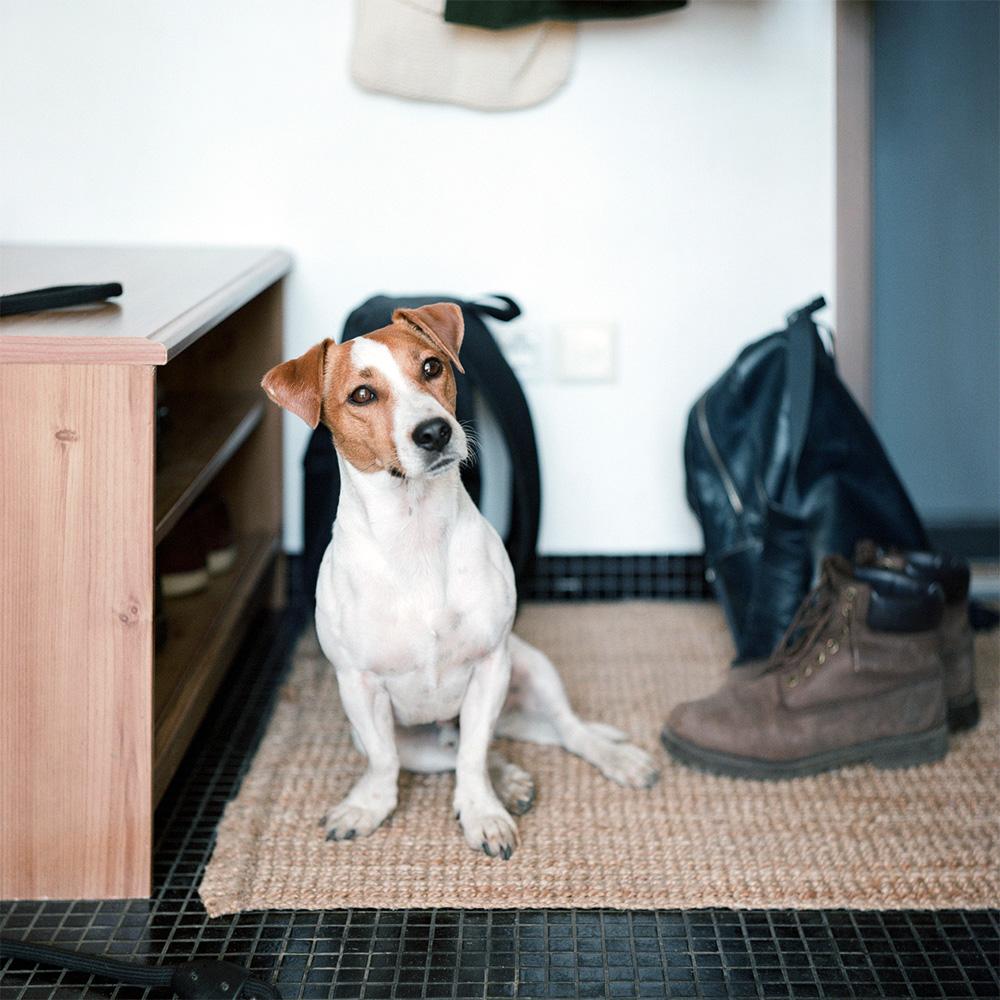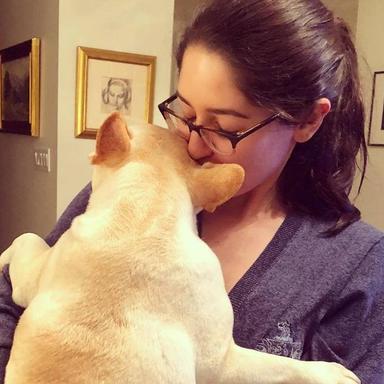Stop Your Dog’s Territorial Marking Inside
Learn effective methods to prevent and manage your dog
Learn effective methods to prevent and manage your dog
by Julie Zeilinger, | February 16, 2024

Duet Postscriptum / Stocksy
When a new dog moves into your home, it is not at all uncommon for them to feel the need to “raise the yellow flag” and claim their new territory as their own by marking it with some urine. Since many newly adopted dogs are already housebroken, this may just be a one-time incident — but it could be a recurring problem.
One of the causes of territorial marking is hormones, and the other is social communication. Your dog might be trying to stake their claim on a territory, or they could be letting you know how they feel about that new couch (household changes are a huge trigger for urine marking).
Knowing how to stop a dog from marking inside can be tricky. Luckily, there are a few simple “tricks” you can try to put a stop to that leg lifting or squatting. Read on for five tips about how to stop a dog from marking inside your home.
The first step to help stop your dog from marking in the house is to determine why they are doing it. Start a log and note the times and locations of your dog’s marking habits. Is your dog marking in one spot or multiple spots? Do they mark only when alone or in front of you? Did they suddenly begin marking in the house when they previously weren’t? Make a record so you can better assess the root cause. This also gives you a starting point when you reach out to your vet.
Even a dog who was fully housebroken in their prior home or foster home will need time to adjust to your schedule, including going to the bathroom on a new routine and in new places. Just like in housebreaking, make sure to give your dog as many potty breaks as possible in the beginning, on a schedule, and praise them when they go outside.
Bladder or urinary infections can be painful and cause a dog to urinate urgently and frequently. Make a vet appointment ASAP to rule out this cause. If your pup isn’t altered, this is another reason to consider doing so. Spay/neuter surgery will often eliminate hormonally-driven marking, but it does take time for hormone levels to subside enough to make a difference. If your dog was just altered, treat them as you would an un-housebroken dog and go back to house training 101.
If you don’t completely get rid of the pee smell, your pup might keep marking their territory in the same spot. Soak the area with a pet urine enzyme cleaner and let it fully dry. If your home is humid or has wall-to-wall carpeting or upholstery, you can use a hair dryer to speed up the process after one day. Do not allow your dog access to that area while it is drying. If there is a removable carpet in that area (doormats are popular pee spots), put it outside.
The key to stopping your dog from marking is prevention. If you’re not directly supervising your pup, temporarily crate them or keep them gated off from the spots they were marking. While your dog is out of their crate, don’t let them out of your sight. Look for signs that your dog is getting ready to mark (sniffing around, lifting their leg, circling around, etc.), then follow these steps to stop scent marking:
If they’re about to mark, interrupt them with a short and abrupt sound (Aarp!).
Redirect them outside, and reward them if they pee.
Repeat.
If your dog is marking in one spot repeatedly, put your dog’s crate or bed on top of that “marking spot” or try to block the spot as much as possible. Often that’s all it takes, although some dogs will still raise the flag on their crate but not their bed. If the bed or crate stops your dog from marking, keep it in that spot for at least two weeks. If the bed/crate doesn’t work, try their food and water bowls. If that works, feed your dog there for two weeks.
Belly bands can be a training tool, but they do not address the root causes of why your dog is marking. They should not be a replacement for properly house training your dog. When in doubt, consult a trainer to see if a belly band can be a useful tool for your dog. The idea behind belly bands is that dogs are less likely to mark when they feel wetness against them.
What is a belly band? Belly bands are a cloth wrap, kind of like a diaper, that goes around the waist of a male dog to discourage them from peeing in inappropriate places.
Are belly bands humane? There is some debate over whether or not belly bands are humane; when used correctly, belly bands are not cruel. Belly bands should be a temporary measure used in conjunction with training and only while supervised.
Can a dog wear a belly band all day? Belly bands should not be worn constantly; they should be changed every three to four hours or as soon as your dog soils them to avoid irritation. They also should not be worn when pet parents aren’t around to supervise so they don’t get caught on furniture or otherwise cause your dog harm.
In addition to training, some have found using an ADAPTL (dog appeasing pheromones) collar, diffuser, or spray helpful in calming their anxious dog, which helps stop territorial marking. These collars are about $10 at pet stores, and most vet offices carry some version of it, too.
Here is one real-life example of how one adopter worked through territorial marking with their newly adopted dog, Max. The first week Max was with his adopters, he didn’t have any accidents, but then he started to pee in his parent’s studio, where he slept at night, was fed, and was kept while alone in the house. It also happened to be a spot where the adopter’s previous dog had accidents when she was sick. Max’s new parent never left him alone for more than two hours at a time outside of bedtime, and he was walked and played with regularly, but he continued to pee inside — even if he had been out shortly before.
Because Max was marking in one spot repeatedly, they followed the above advice: They cleaned the floor with an enzymatic cleaner and put his bed on top of the spot, and Max stopped marking the area.
Is there another underlying behavioral issue? Issues like marking can be exacerbated by a lack of training and discipline; pets need guidance to help them navigate the human world. Lack of training is the number one reason dogs end up in shelters. Training a dog — especially a puppy — can be overwhelming and takes some time, but many behavior issues have relatively simple solutions, and the advice of a good book, trainer, behaviorist, or veterinarian could help. You could also try a local trainer who uses positive, humane training methods. You can choose from a variety of training methods ranging from group classes to private, in-home lessons to board-and-train.
Figuring out how to stop a dog from marking inside may take some time and patience, but it will be well worth it when you start to see results.
What if you’ve exhausted all these resources and still could not get to the root of the problem? Our experts at Rehome by Adopt-a-Pet.com understand how difficult it can be to figure out the best course of action. While we always want to find ways for you to work through behavior and training issues and keep your pet, if you are struggling and have started thinking about rehoming your pet, Rehome — a peer-to-peer adoption service that allows pet owners to post their pets on Adopt-a-Pet.com to be seen by millions of potential adopters — could be a good resource for you.
First, assess the marking behavior, then make sure they get enough potty breaks, take them to their vet, or pursue other tips in this article.
Dogs mark to advertise their presence and claim territory and resources.
First, assess the marking behavior. Then pursue the advice in this article based on their behavior and potentially consult a veterinarian.
No, positive reinforcement is a more effective training method than punishment.
Belly bands prevent your dog from marking on your possessions or surfaces but do not address the root causes of marking.
Belly bands are not cruel if used correctly. They should remain on dogs for no longer than three to four hours and should be replaced immediately after being soiled.
A Commonsense Approach to the House-Soiling Dog
Patterns of Scent Marking with Urine and Faeces Amongst Carnivore Communities

Julie Zeilinger is a NYC-based writer and editor whose writing has been published in Marie Claire, Vox, HuffPost, Forbes, and other publications. She is also the author of two books: College 101: A Girl’s Guide to Freshman Year (2014) and A Little F’d Up: Why Feminism Is Not a Dirty Word (2012). She is the mom to Baloo, a two-year-old Bichpoo and foster mom to dogs via Badass Animal Rescue.